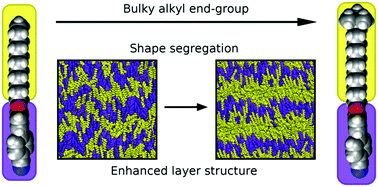Shape segregation in molecular organisation: a combined X-ray scattering and molecular dynamics study of smectic liquid crystals†
Abstract
Temperature-dependent X-ray scattering studies have been carried out on 4-undecyloxy-4′-cyanobiphenyl (11OCB) and 4-(12,12-dimethyltridecyloxy)-4′-cyanobiphenyl (t-Bu-11OCB) in the smectic A phase, from which their layer spacings and translational order parameters were obtained. Marked differences between the layer structures of the two compounds were demonstrated, showing that the addition of the t-Bu group results in a higher translational order parameter and wider layer spacing for t-Bu-11OCB than 11OCB. Fully atomistic MD simulations of both compounds run for >1000 ns demonstrated the spontaneous formation of smectic mesophases from isotropic starting geometries, and experimental trends in order parameters and absolute layer spacings were shown to be replicated well. Further analysis showed that both the aromatic head-groups and the alkyl tail-groups exhibit interdigitation in the simulated smectic phases of both compounds, and the difference in the layer structures between 11OCB and t-Bu-11OCB could be attributed mainly to a shape segregation effect arising from the addition of the bulky t-Bu end-group to the alkyl chain.



 Please wait while we load your content...
Please wait while we load your content...